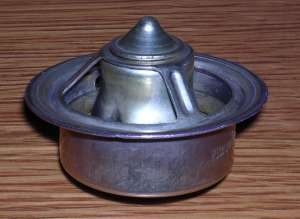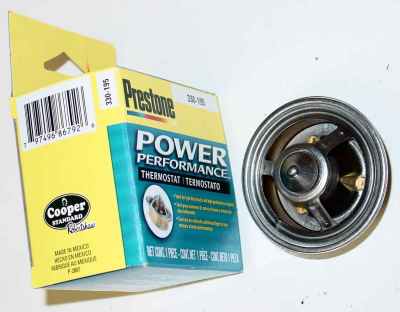
De Re Thermostats
(Or, "Why your thermostat is not doing what you think it is," in which your humble narrator attempts to dispel some of the myths surrounding thermostats and engine cooling)
-
Myth 1: "My engine is overheating."
Well, perhaps it is, but more likely, it's not. There are several reasons.
Just because, as some people believe, the temp gauge needle is 1/128" past 'N' does not indicate that the engine is overheating. For starters, MG temp gauges are not exactly precision instruments. The fact that the only markings on the gauge face are 'C', 'N', and 'H' are your first clue that the gauge cannot be used to get an accurate measurement of engine temperature. All you can really tell is there is a range of temperatures considered normal (but no indication of numbers involved) and that below that is cold and above that is hot. Note that I said "range" -- engines do not run at a constant X degrees. Rather, they run at a variety of temperatures, influenced by load, state of tune, ambient temperature, thermostat operation, cooling system efficiency, etc, etc, etc. So a "normal" temp could be anywhere from just above 'C' to just below 'H'. Modern cars and the engineers who design them have spoiled us -- they engage in some digital jiggery-pokery so that the gauges don't show this variation. They engineer the electical systems so that the gauge stays rock-steady in the middle, even while the real engine temp is bouncing all over. They do this so that the cars' owners don't get alarmed, but it's really not much better than having just an idiot light.
So assume your needle is halfway to 'H' -- you're not necessarily overheating. Is it boiling over? Is the engine pinking like mad and running rough? No? Then it's fine. Don't worry about it.
So what is overheating? The symptoms just mentioned are the giveaways. Anything less is not overheating. If you're still concerned, buy or borrow an infrared thermometer and find out what ACTUAL temperature is associated with that alarming gauge reading. (You could also stick you wife's meat thermometer in the radiator filler, but wash it before you put it back and don't tell her I told you to do it! I was never here and we never had this conversation. ;-)
Water, at atmospheric pressure, boils at 212ºF. Mix it 50/50 with antifreeze, and the resultant coolant boils at around 230ºF. If you put it under pressure, the boiling point goes up 3ºF for every addition 1 p.s.i. With a 16 p.s.i. cap (which is what the last MGBs used, and should be suitable for all MGBs), that's an additional 48ºF. So you won't overheat until almost 280ºF!
-
Myth 2: "I'm overheating, so I need a colder thermostat."
Changing thermostats to a different rating cannot cure overheating; it can only cure overcooling. To understand why, you need to understand why a thermostat determines only the minimum operating temperature. Let me repeat that: A thermostat determines only the MINIMUM operating temperature, not the maximum temp. Keep reading to see why.
An engine takes energy stored in fuel and releases it by burning the fuel. Some of the energy (less than 25%) gets converted to kinetic energy (motion) to turn the engine and ultimately the wheels. A little bit of it gets turned into vibrations (actually, another form of motion) that we can feel and hear. The largest part of it gets turned into waste heat. This thermal energy flows into the engine parts to be carried to the radiator by the coolant (or remains in the combustion gases to be carried out the tailpipe). The radiator dumps it into the atmosphere. Any energy that makes it to the radiator is lost, having done you absolutely no good whatsoever. Under normal conditions, a cooling system in good repair can shed heat faster than the engine can produce it, so you need something to limit the capacity of the cooling system to dump heat. That's the thermostat's job.
Imagine an engine that is at normal operating temperature. Say, for instance, that you're driving along a ridge road in the mountains. At the moment you're neither climbing nor descending, there is a lot of air going through the radiator, and the thermostat is open. Now suppose you turn off the ridge road and start descending a steep hill into a valley. The cooling system is dumping heat like mad and the engine is producing very little, so the engine starts to cool down. The thermostat notices this (it sees the coolant temperature falling) and begins to close. Because there is now less coolant flowing through the radiator, there is less heat being carried to it for disposal. The thermostat keeps the engine from becoming too cold. Because the thermostat is limiting the amount of heat being carried the radiator, after a while the engine temp starts to rise again. Once it's high enough, the thermostat opens.
Now you've reached the bottom of the valley, and you start up the hill on the other side. The engine is really working hard now, and there's less air through the radiator because you're going slower. Since the engine is making heat faster than it's being carried away, it begins to get hotter. The themostat is already fully open, so there's nothing it can do. The engine gets hotter and hotter. If this carries on long enough, the radiator will boil over. It has overheated.
Another way to think about it is this: Imagine that you live in Florida in a house with no air conditioning. On a sweltering August afternoon, turning the furnace thermostat down from 68ºF to 60ºF won't make you feel any cooler!
So you see, a thermostat cannot prevent overheating. It only prevents overcooling. A thermostat can only be the cause of overheating if it is defective and doesn't open as it should.
The fix then, if your engine is truly overheating, is obviously not to put in a cooler thermostat, but to fix the fault in the cooling system. A cooler thermostat is just a band-aid that at best can only temporarily mask the problem. If the cooling system is marginal, it might buy you a little time before the engine overheats, but not much. Find the real problem -- a clogged radiator, a water pump with a defective impeller, too much scale in the engine, or a bad distributor.
A bad distributor, you say? Yes! If your timing is incorrect, then you're losing power. Power = energy. If you're losing power, then that energy has to go into the cooling system. Furthermore, the engine will have to work harder and put even more energy into the cooling system. Carl Heideman at Eclectic Motorworks says that you lose about 1 HP for every 1º your timing is off.
-
Myth 3: "A cool engine is a happy engine"
Actually, the hotter an engine is, the more efficient it is. It makes more power, lasts longer, and uses less fuel. Remember I said that energy can either be used to turn the wheels or dumped as waste heat? Energy will tend to "follow the path of least resistance." If there is a large temperature differential between the combustion gases and the cylinder walls and head, the thermal energy in the gases will flow readily into the cool engine parts. If you reduce that temperature differential by making the engine parts hotter, less energy will flow. A hot cup of coffee in a refrigerator will cool down quickly and will cool to the temperature of the 'fridge -- a big temperature drop. On the kitchen counter, it will cool more slowly and will fall less (only to room temp). In a 200 degree oven, it won't cool at all. Same thing in your engine -- make the cylinder walls hotter and the thermal energy won't flow into them as readily. But that energy still has to go somewhere. Some will stay in the combustion gases and go out the tailpipe, but some will go into turning the wheels. So by trying to keep the engine temp low, you're throwing away perfectly good energy (and money)!
Here's what Peter Burgess, well-known MG tuning guru, says in his book "How to Power-Tune MGB 4 Cylinder Engines": "The ideal 'stat is 88 degrees Celcius (190F)." Here's what the late, great Smokey Yunick, a god of internal combustion, said in his book "Power Secrets": "It is easy to see how overheating can be a problem, but I think some racers overlook the fact that it is possible to 'overcool' the engine. Some guys go to great lengths to keep the engine temperature down to 180 degrees. And, though the engine doesn't overheat, they don't realize that they're putting energy (heat) into the cooling system that could be used to produce power at the crankshaft. Running the engine at 180 degrees will drop the overall horsepower by 2%-3%. For max power the cooling temp should be at least 200 degrees...."
-
Myth 4: "The book says I need a cooler thermostat for summer, so I should put one in."
Yes, it does, and no, you shouldn't. The march of technology has made some of the information in the service guides obsolete. Older engines (in general -- not just MG engines) typically used cooler thermostats not to keep the engines cooler but to keep the oil cooler. Oils of days gone by would coke at relatively low temperatures, so engines were run cool to prevent this. This was a big problem in hot summer weather. Today, oils are engineered to withstand higher temperatures. Modern cars have thermostats rated at 195 degrees or higher and have no problem with oil coking.
Also, before the days of ethylene glycol antifreeze, the antifreeze used was alcohol. Alcohol has a lower boiling point than water, so by keeping the coolant temp as low as possible, the alcohol was not driven out of the system as quickly. This was more important in the winter, obviously, so cars typically had winter thermostats that were, while warmer than their summer thermostats, still colder than those in modern cars.
Those days are gone, though. Therefore, your MG can use a higher rated thermostat than the book says with no problems. "The book" was written with 1950s (or 1960s, or 1970s) lubrication technology in mind. The state of the lubricator's art has progressed far beyond that now.
The other side of that coin is that cold oils do not lubricate well, so it's best for your engine to get the oil to full operating temperature quickly for the least engine wear. Cold starts are hard on engines -- the oil is thick & goopy, there's unburned fuel washing down the cylinder walls, and moisture from combustion is condensing out in the engine. Water and fuel are lousy lubricants. And water in the oil will react with combustion byproducts to form acid. The acid in turn will start eating away at the internals of your engine. Oil manufacturers put in additives to buffer the acids, but once those are exhausted you have no protection. The faster the oil gets hot, the faster it can start lubricating and the faster all the nasties can get driven out of it. This is also why you should cover your oil cooler in cold weather (or install an oil thermostat in the cooler hose.)
UPDATE Apr 2007: You may have noticed that the thermostat pictured above is a little different from what you may be used to. It's an old Balanced Flow® thermostat made by RobertShaw Controls. It's a nice design, but RobertShaw no longer make them. Bob Muenchausen kindly sent me the picture below and informed me that the design has been purchased by and is being manufactured by Cooper Automotive. They're being sold under the Prestone brand. If you run across one in the parts store, consider using it!
